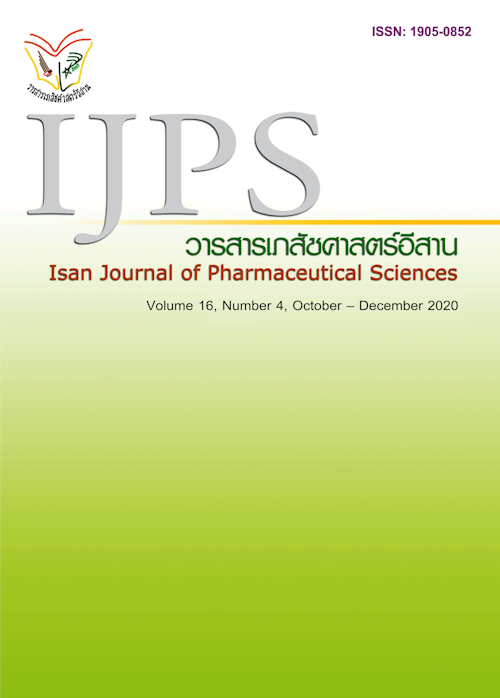Situations of implementation of pharmaceutical cost containment policies in Phimai hospital, Nakhon Ratchasima province
Main Article Content
Abstract
Phimai Hospital is a 150-bed hospital with 6 medical specialists. This hospital also provides the medical education for medical students. Pharmacy and Therapeutics Committee (PTC) has imposed policies to control pharmaceutical expenditures. This research aimed to study the situation and analyze the results of implementation of pharmaceutical cost containment policies. Method: This was a mixed method research including both quantitative and qualitative research methods. Retrospective study was used as a quantitative research method. Outpatient prescribing information in the fiscal year from 2014 to 2017 was obtained from electronic medical record. Qualitative research methods included face-to-face and in-depth interviews. Documents and meeting reports conducted by the PTC, between the fiscal year 2011 and 2017, were comprehensively reviewed. 18 doctors, 3 nurses and 3 pharmacists were interviewed individually. Focus groups comprised 5 people being members of Pharmacy Therapeutic Committee Board. The CIPP model was applied for evaluating the implementation of pharmaceutical cost containment policies. Content analysis was used to analyze qualitative data. Results: Measures which were used for controlling pharmaceutical cost were consistent with the hospital context and the Ministry of Public Health policies to control medicine expenditures and rational use of medicines. The study samples knew about causes of increased pharmaceutical expenditures. For input domain, most of the study samples knew the measures used for controlling pharmaceutical expenditures and promoting rational use of medicines in the hospital. For process domain, the study samples could access the information of pharmaceutical expenditures and perceived that pharmaceutical cost containment policy were continually monitored. They gave comments that the measures were effective.For product domain, the study samples reported that they complied to the policy and provided education for public to raise their awareness on rational drug use. According to the cost containment policy which targeted to the four drugs including carvedilol 25 mg, celecoxib 200 mg, gabapentin and lercanidipine 20 mg, approximately 98.12% of the prescriptions were prescribed in compliance with the specific criteria established for the restricted use of these certain drugs. Conclusions: Measures imposed for controlling pharmaceutical costs were practical and widely accepted by the practitioners. Monitoring and evaluation should be continuously performed and such information should be disseminated to practitioners.
Article Details
In the case that some parts are used by others The author must Confirm that obtaining permission to use some of the original authors. And must attach evidence That the permission has been included
References
Arshad S, Mahmood S, Rasool S, et al. Rational drug use in Pakistan: a systematic review. J Pharm Pract Med 2016; 2(4): 116-122.
Hoadley J. Cost containment strategies for prescription drugs: assessing the evidence in the literature [Online]. 2005 Feb 28 [cited 2016 Jun 7]. Available from: http://kff.org/medicaid/report/cost-containment-strategies-for-prescription-drugs-assessing.
Limwattananon C, Thammatacharee N, Waleekhachonloet O, et al. Expenditure of Civil Servant Medical Benefit Scheme and the use of non-essential medicines. Journal of Health Systems Research 2011; 5(2): 149-159.
Limwattananon S, Limwattananon C, Pannarunothai S. Cost and utilization of drugs prescribed for hospital-visited patients: impacts of universal health care coverage policy [Online]. 2004 [cited 2016 Jun 7]. Available from: http://kb.hsri.or.th/dspace/handle/11228/1851?src=?2fdspace.
Nayeemul Islam K. A study on generic prescription substitution policy as a cost containment approach for Michigan’s Medicaid system [Online]. 2013 Oct [cited 2016 Jun 7]. Available from: http://pdfs.semanticscholar.org.
Office of the National Economics and Social Development Council. Total health expenditure per capita gross domestic product [Online]. 2017 [cited 2017 Jun 7]. Available from: http://social.nesdb.go.th.
Office of the Permanent Secretary. Strategic Plan of the Ministry of Health Year 2017-2021 [Online]. 2017 [cited 2017 Jun 7]. Available from: http://203.157.229.33>downloadpage>file.
Ratanawijitrasin S, Kulsomboon V. Health insurance system in Thailand. Design Limited; 2001.
Sirisorn W, Ploylearmsang C, Waleekhachonloet O. Role of pharmacy and therapeutic committee and generic drug policy in perspective of medical personnel in a tertiary hospital Thailand. Journal of Science and Technology Mahasarakham University 2014: 793-802.
Suanrueang P, Sakolchai S, Suriyawongpaisarn P, et al. Measures for promoting rational use of high cost drugs in hospitals under Civil Servant Medical Benefit Scheme. Journal of Health Systems Research 2013; 7(2): 223-234.
Tele P, Groot W. Cost containment measures for pharmaceuticals expenditure in the EU countries: a comparative analysis [Online]. 2009 Jul 23 [cited 2016 Jun 7]. Available from: http://pdfs.semanticscholar.org.


